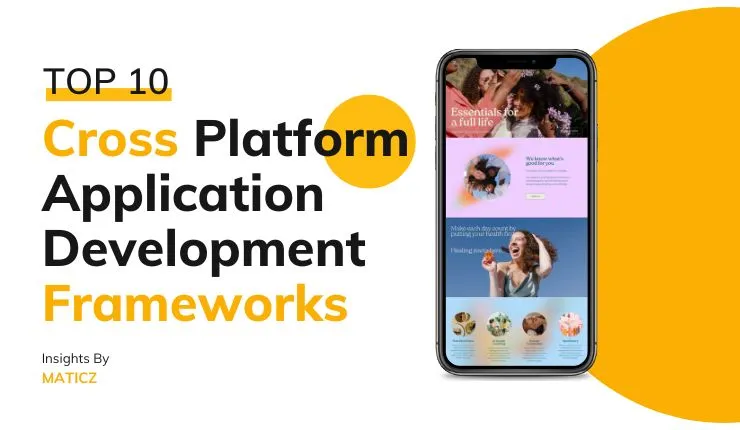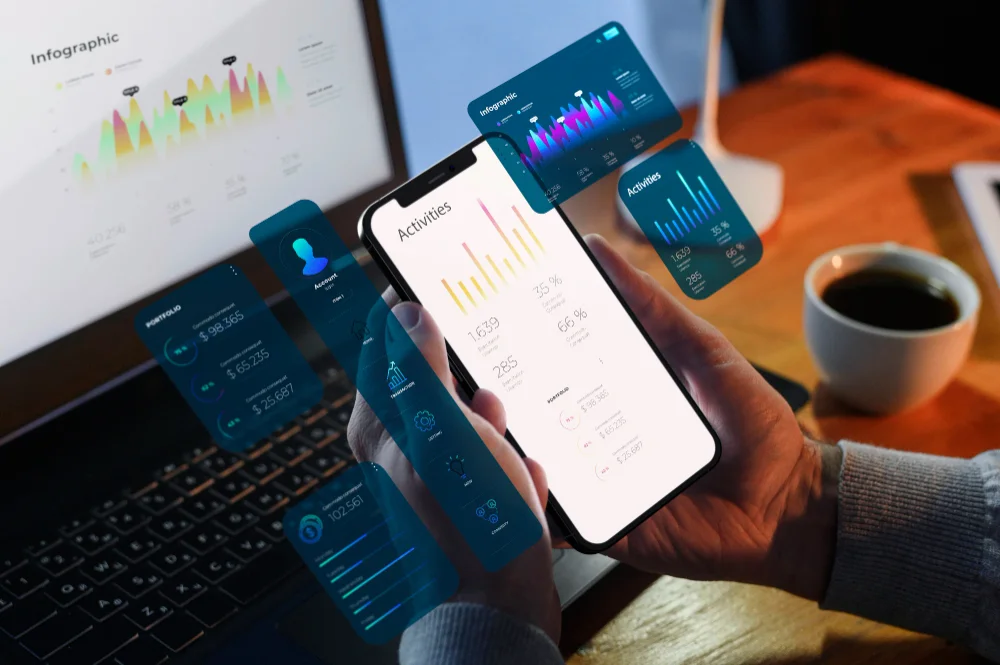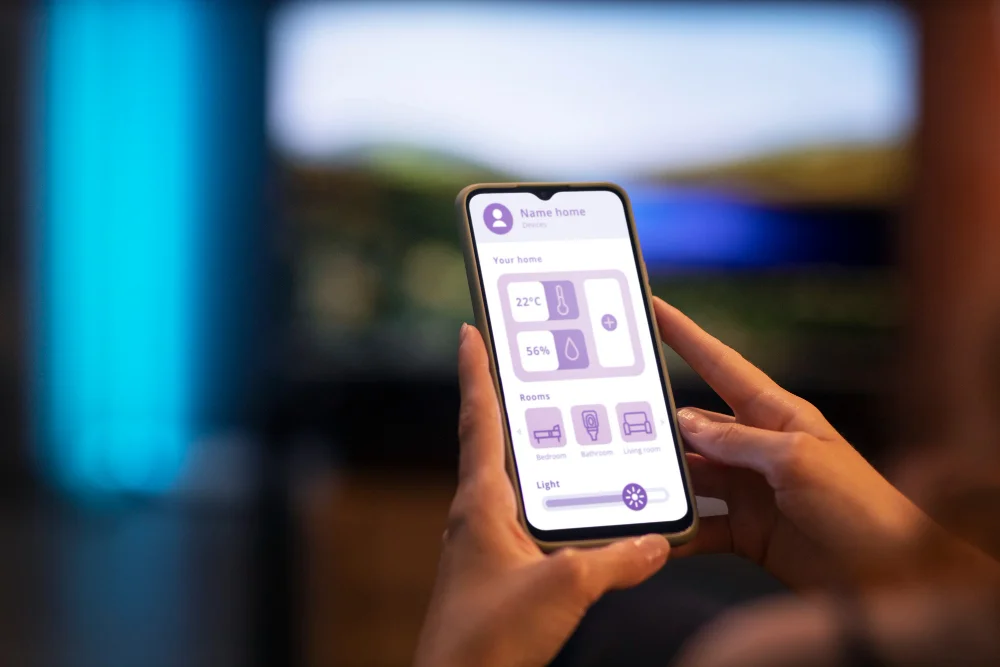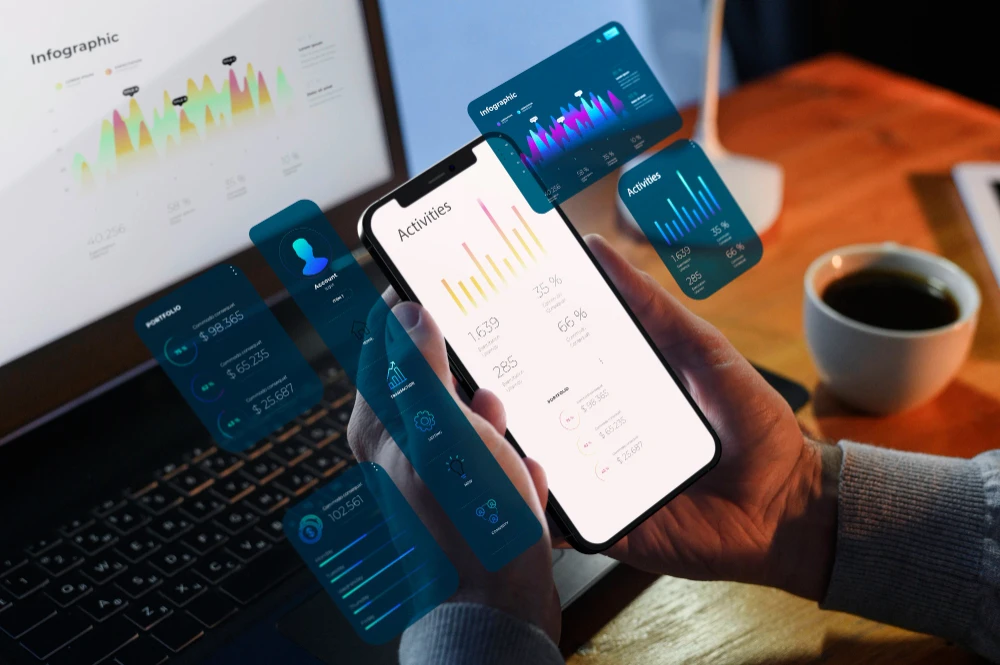Share Posts

Top 10 Cross Platform App Development Frameworks in 2025
52
3350
103
What is a Cross Platform App Development Framework?
Cross-platform app development framework is software created for native-looking applications compatible with any OS like Android, iOS, and Microsoft Windows. This means mobile app engineers need not create coding for separate platforms but rather create one coding that will support all platforms. This is a widely preferred method for building mobile app development frameworks.
10 Best Frameworks For Developing Cross-Platform Mobile Apps
Here are 10 of the best frameworks for developing cross-platform mobile apps:
Flutter
Flutter by Google is a software development kit widely preferred among cross-platform app developers globally for efficient and high-quality native interfaces on the iOS and Android platforms. Flutter is regarded as a UI software to build apps that run with uniformity and progressiveness. Flutter aims to add more features to its platform even though it already exists as a great development. Check out the features of Flutter
Features of Flutter
- Hot Reload
Developers can easily modify the features while testing making it a vital part where developers save so much time especially when working on a bug or a feature.
- Requires Less Coding
Dart, Flutter’s major component and its programming language is strongly typed and completely object-oriented, Dart achieves this with the help of AOT (Ahead-of-Time) compilation, while JIT (Just-in-Time) compilation is employed to streamline the development process by facilitating hot reload during development without the need for a fresh build.
- Multiple Themes
The platform offers multiple themes for developers that ultimately result in distinguishing colors and styles between iOS and Android.
Ionic
Ionic is one of the popular cross-platform app development frameworks, it is an open-source UI framework for designing. The framework includes accelerated transitions and touch-optimized gestures to enhance the speed and performance of applications. Its unified codebase allows developers to craft adaptable UIs for various major operating systems. Additionally, developers have the option to select visually appealing themes, customize form controls, incorporate inline overlays, and incorporate various other features.
Features of Ionic
- Alterations to the Code Structure
Ionic permits changes and alterations in the code structure tailored as per the developer’s requirements and significantly saves time.
- Command Line Interface
The command line interface provides a lot of commands, which serves as the go-to tool for ionic developers
React Native
React Native has been the go-to framework for cross-platform apps making it very appealing among developers. The advantages of JavaScript and React.JS are integrated with the ability for developers to create Objective-C, Swift, or Java modules for React Native. Additionally, developers can easily complete complicated tasks such as video processing, image editing, and other tasks that are outside the scope of the framework by utilizing the native modules and libraries in React native cross-platform projects. The React Native framework comes with several code editors that may be used to alter projects in the future along with the community support for the technology is on par.
Features of React Native
- UI Focussed
Creating any App’s user interface is one of the most vital aspects of developing a mobile app. With react native placing a good amount of emphasis on UI design it has come across as a popular choice. Creating the app's User Interface (UI) is one of the most important aspects of developing a mobile app. Because React Native places a great deal of emphasis on UI design, it is a popular choice. The rendering capabilities are very responsive and unmatched.
- Programming Language
Developers are inclined to a web development framework if it leverages a popular and frequently used programming language. JavaScript is a popular programming language used with React Native. JavaScript is the third most used programming language on the internet, besides HTML and CSS. JavaScript is a fundamental language that is widely used by developers of all skill levels, from novices to seasoned professionals
Node.JS
A fantastic framework for creating cross-platform applications is Node.js. Based on the Chrome V8 JavaScript engine, Node.Js is essentially a JavaScript runtime framework. Regarded as an excellent open-source platform that facilitates the creation of scalable, server-side networking applications, Cross-platform Node.js frameworks are by nature opulent, responsive, and efficient.
The framework can manage several connections simultaneously. Additionally, it has a vast library of JavaScript modules that make web application development easier.
Features of Node.JS
- Scalable Web App Development
Node.JS is built with keeping scalability in mind, compared to other web backend development solutions, Node.JS permits multiple threads to run simultaneously and interact with the other thread. It has a cluster module accountable for maintaining and balancing every CPU-bound task regarded as one of the main features of Node.js. Running more than one node is made possible with Node.Js balancing the workload.
- High Performance
Regarded as the best software for executing high-performance tasks and meeting with considerable quantified data to process at the same time. Node.JS turned out to be the best choice for backend development that interprets Javascript code to Google’s v8 javascript engine. It has become easier to compile the code into machine code directly thanks to the Node.JS web app development engine and implementation.
NativeScript
NativeScript comes across as a stupendous free cross-platform framework based on Javascript, Typescript, and CSS. Nativescript puts together javascript into native code for optimal performance thereby supporting popular frameworks and offering prebuilt UI components for easy integration.
It is an excellent choice for developers looking for the WORA functionality. The framework offers native APIs, allowing the developers to reuse all existing plugins.
Features of NativeScript
- Bundle Workflow
Developers will have access to bundle workflow that permits bundling the source code in a unified and effective manner for cross-platform app development. The command line interface makes apps in two types, legacy workflow, and bundle workflow, either depends on the web pack mainly for bundling the source code into the output files. At the same time, legacy workflow duplicates the source code directory itself.
- Kendo Themes Support and Theme-sharing
Faster time to market is given emphasis, which drives all developers to minimalize the development period. To achieve this many mobile app developers are concentrating on establishing a shared and accessible generic codebase that constitutes building mobile apps and online apps in a shorter time.
Corona SDK
Corona SDK comes across the platform for 2D app development framework for mobile apps like Windows and Kindle compared to other renowned platforms. It ensures quicker game and mobile app creation. Corona SDK is regarded as a dependable, powerful, quick, and lightweight backend infrastructure, multi-paradigm programming language Lua is the catalyst for speed, extensibility, and portability. Additionally, it is a free framework that supports real-time testing and runs on both Windows and Mac OS X.
Features of Corona SDK
- Responsive to Code Changes
When any code changes are entered it has an immediate response and results in an instant real-time preview
- Plugins Availability and Support
Corona SDK framework supports a whopping 200 plugins that include in-app advertising, analytics, media, and hardware features.
Xamarin
With the help of the cross-platform mobile app development tool Xamarin, developers may share up to 90% of the code between popular platforms. With a developer community of over 1.4 million, this relatively new tool is built on the Microsoft technology stack. Xamarin is the perfect platform for developers looking to code and test business logic
Features of Xamarin
- Complete Binding of SDKs
All platform SDK bindings are included in Xamarin, covering mostly every underlying SDK for iOS and Android. Additionally, these bindings are strongly typed, making them easy and simple to use and browse while offering reliable code-checking both during development and compilation time. Applications with stronger typing and fewer runtime errors are produced via strongly typed bindings.
- Modern Language Constructs
Modern language structures: C#, the language used to write Xamarin apps, has several characteristics that make it far better than Objective-C and Java, including functional constructs like lambdas, LINQ, parallel programming, generics, and more.
Appcelerator Titanium
Using JavaScript and the Titanium API, which encapsulates the native APIs of the mobile platforms, the Appcelerator Titanium SDK facilitates the perfect development of native cross-platform mobile apps. Titanium gives developers the ability to develop fully functional, immersive applications with over 80% code reuse for mobile apps. Titanium is licensed by TiDev under the Apache Public Licence (Version 2), which is fully free for personal and business usage and authorized by the OSI.
Features of Appcelerator Titanium
- Arrow DB
A schema-less data store, Arrow DB permits developers to deploy data models with minimal additional efforts to set up.
- Availability of Tools
Appcelerator provides a range of tools for quickly developing applications. This suggests that to assess how users interact with UI, a prototype can be made in less time and effort.
PhoneGap
PhoneGap development takes minimal time, the software developers are building can be released to users much sooner. The mobile app developer might accomplish the desired outcome faster by maximizing the utilization of already acquired abilities and easily accessible SDKs. An additional helpful tool for testing and debugging is the PhoneGap Emulator.
Features of PhoneGap
- Payment Integration
Payment integration and distribution by the PhoneGap-developed app store are both quite simple.
- App Store Discoverability
Every PhoneGap app can be installed as quickly as native applications; it enables you to leverage the app store discovery ability.
Sencha Touch
Sencha Touch is primarily used to facilitate the designing of quick, high-performing, and efficient apps that leverage hardware acceleration techniques. Sencha Touch was built to make it easier for web developers to use their expertise in HTML, CSS, and JavaScript to create cross-platform mobile applications.
It is highly comparable to the developer-friendly Ext JS JavaScript framework. Sencha Touch is regarded as the only framework that provides developers with the best options for quick and fascinating native apps that run on Kindle, Fire, iOS, Android, and other platforms.
Features of Sencha Touch
- Code Compatibility
Sencha Touch offers code compatibility between the old ones and the new ones, it is also loaded with plugins with 50+ built-in widgets making it a collection of rich UI like lists, carousels, forms, menus, toolbars, etc., created specifically for mobile platforms.
- Cordova Integration
One of the most celebrated features of Sencha Touch is that it supports Cordova integration for native API access along with the packaging.
5 Reasons to Use Cross-App Development Framework
Code Reusability
Codes can be reused and used across multiple platforms, this constitutes the fact that developers need not write customized and individual codebases for every platform. Resuability of the same reduces time and maintenance saving resources during the development process.
Cost Efficiency
Once coded should be run everywhere in the context the whole cross-app development framework was initiated. Development costs are minimized and the saved-up costs could be used for other supplementary costs. Cross-platform applications are thus the only viable option for improving your business across several platforms and technologies.
Faster Development
The development process is typically faster when using a common codebase by developers as opposed to creating unique apps for every platform. This is because they don't have to duplicate work for every platform by reusing code. In a competitive industry, quicker development might result in cheaper costs and a quicker time to market for the app.
Accessibility to Native Features
Cross-platform frameworks provide developers access to the device's native capabilities and regular functionalities, such as the GPS and camera. This may improve the user experience and provide each platform with unique features.
Future Proofing
Businesses may future-proof themselves against shifts in the market, like rearranging the market share of operating systems, by creating cross-platform applications. Without having to start from scratch, apps may be readily changed to work on new platforms or devices.
Maintenance Friendly
Cross-platform programs just require one codebase, making upgrades and maintenance quick and simple. Instead of working on several platform-specific codebases, developers only update one codebase, which lowers maintenance costs and minimizes app downtime.
Why Cross-Platform App Development Framework is the One for Your App?
Embrace the power of cross-platform app development frameworks to elevate your business to new heights! With a cutting-edge framework, you can unlock cost savings, lightning-fast time-to-market, and a seamless user experience across all devices.
Bid goodbye to the hassle of managing multiple development teams and upscale your return on investment with a streamlined approach. By leveraging the latest in cross-platform app development framework technology, businesses will reach a broader audience than ever before while maintaining the native look and feel users love.
Maticz for Cross-Platform App Development
Maticz, is renowned as the best cross-platform app development company, following agile and nimble methodologies. Our portfolio speaks loudly of successful and scalable projects, ranging from simple apps to complex prototypes using cutting-edge technologies.
A comprehensive selection of React Native, Vue, Angular, and Node.js development services that cater to different business goals are provided by our industry’s best cross-platform app developers.
We have a buoyant history of developing scalable, future-ready mobile apps, as seen by our portfolio of completed successful projects. Our experts can effectively create a broad variety of mobile apps, from straightforward prototypes to intricate, feature-rich solutions. Seek the best mobile app development company - Maticz to get your cross-platform app developed with accomplished results.
Tap Into the Future
The latest insights, posts, and project updates - straight to your inbox.




